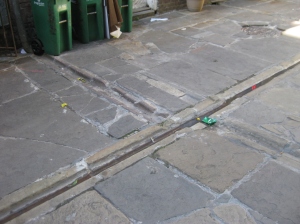I took a look at the new addition to the Hudson River waterfront, the Little Island, and it set me off on an extended internal riff about illusions and the artificial. Coincidentally, I finished up my little foray into the Chelsea district of Manhattan by visiting the Museum of Illusions, a sort of “chain museum,” in that it has sites in many cities. It was very well done, and a lot of fun.
As for the new park, it is certainly in the grand tradition of 18th garden follies, as the review in the NYTimes commented. The planting is lush, the views are spectacular, the engineering is amazing (although I have had a hard time finding out just exactly how those “tulip” buckets were constructed), but the whole thing is just a little bit…weird and kooky. There is a strong Disneyland feeling, and maybe that’s intentional, but the place feels like a an expensive bauble strung to the waterfront necklace of NYC. Good thing that Diller is footing the bill for maintenance for the next twenty years, because as the Times noted, it’s likely to cost a “king’s ransom.”
I suppose you could say Little Island is more E.A. Poe “Garden at Arnheim than Disneyland, but in any case, we’re firmly in the realm of the artificial. Not fake, mind you, but the product of artifice. And that’s art, with a capital, or maybe lower-case ‘A’. If it were a a little bit on the perverse side, it might have pleased Huysman’s Des Esseintes in A Rebours, but it’s definitely a family place. And after all, it’s no more ‘naturalistic’ than this favorite space for tourists the world over:

Olmsted gave us a little bit of rus in urbe, nature in the city, but in this more European section of Central Park, he leaned Continental and gave us a little bit of the (Italianate) city in nature, in the nature in the city… Yeah, it’s all how you look at it.
Not too far from this spot is what may be the most visited location in the park, Strawberry Fields, a mosaic in the pathway memorializing John Lennon, near the street entrance across from The Dakota (home of Rosemary’s Baby) where he was murdered. And we know what John Lennon said about reality…and was he just echoing something he’d read?
As I rode public transit across the GWB and downtown on the A-train, I was reading this book from the 1970s that I picked up from the NYRB:

This book is one sustained illusion, a piece of artifice that is amazing to contemplate. It is the story of an empire that existed somewhere in the near east, somewhat contemporaneously with the Roman Empire, except that the Roman Empire is never mentioned, and it seems to be the Roman Empire, except not. Maybe it’s the Eastern Roman Empire, the Byzantine Empire, and the geography seems to match that better, but it really doesn’t matter, because it’s all entirely invented.
The book is a novel, an elaborate historical invention that parallels historical reality, or what we think of as historical reality, or what writers tell us, or have told us, is historical reality, and so on, and on. It is deeply and delightfully ironic and satiric, includes a raft of footnotes that are either completely invented, with authors, sources, journals, and books cited, or sometimes partially invented, and often somewhere in between, requiring a bit of research to determine just where they stand on the line between reality and illusion.
The tone of the book is familiar to anyone who has read a lot of history of the Middle Ages or the Roman and Greek periods of Western Civ that is now slightly old fashioned, that is, stuff written before 1970, say. The cover of the NYRB paperback features an engraving by Piranesi, that consumate re-inventor of the imperial past: his painstaking historical accuracy sometimes gave way to incredible flights of fancy, as in this image, and sometimes it’s not easy to tell if he is giving us reality or fancy, but of course, the reality crumbled to dust long ago.
Reading this book, I had a vague sense that I had heard it all before, and not from the history that I had read, but I didn’t identify the source of this feeling until today. It’s Star Wars! That inexhaustible film franchise is another form taken by the lure of the artificial.

In Star Wars, we have a totalized artificial history that is the mirror of The Glory of the Empire. The novel looks back in time and creates an artificial empire, the movie series looks forward. The novel creates an artificial history that mimics and borrows from actual historical reality and seems as if it could have happened just as the author wrote it. (Of course, the conceit of the novel is that he is writing it as other authors, chronicleers, wrote it, so we have texts written on top of texts…all quite in the manner of J. L. Borges.) In Star Wars, we have a fantastical future realm that lifts all the historical cliches wholesale into an imagined sci-fi future that nobody could believe is real, and that the creators don’t intend anyone to take as real: it’s fantasy for fun.
Star Wars begins from a hazily imagined pas and present, and projects into the phantastical future. What’s so disconcerting about The Glory of the Empire, is that it starts from a perfectly observed present, and imagines a past that we almost feel must have existed given what does exist now. One passage that uses this technique so well is a description of the reunion of the Emperor to-be Alexis with his mother, from whom he has been separated for twenty years. We are told of frescoes by Piero della Francesca that depict this scene – and we can almost believe they exist, especially when we read the footnotes! – and given the paintings by the master that do exist, shouldn’t these be among them? Not to mention the fact that the text goes on to tell us of the immense influence of this narrated/imagined scene on the subsequent history of western art. The passage concludes with a “quotation” from one of Proust’s novels in which a character dies on viewing the frescoe by Piero.
Personally, I have no taste for Star Wars. I prefer my fantasy, my illusions, my artifices with a heavy does of irony and satire. Why would I want to see all the cliches of politics and human folly simply reenacted with high-tech impossible gizmos? But that’s me.
Speaking of artificial islands sculpted into paradisaical gardens, is there ever anything new?







 Posted by Lichanos
Posted by Lichanos 




























